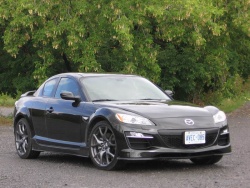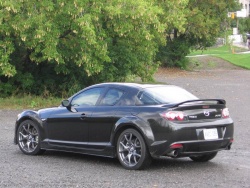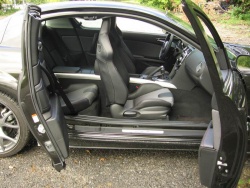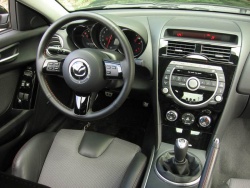 2009 Mazda RX-8 R3. Click image to enlarge |
|
Related links
Manufacturer’s web site |
Review and photos by Chris Chase
The Mazda RX-8 is a cool-looking car, no doubt about it. But what sets it apart has nothing to do with aesthetics, but rather with the unique engine under its hood: the RX-8 is the only mass-produced vehicle of its time to use a Wankel rotary engine.
The Wankel dates back to 1951, when a German named Felix Wankel began developing it while working for automaker NSU. I’ll save you the history lesson and skip to 1967, when Mazda sold its first rotary-powered car, the Cosmo 110S. The RX-7, arguably the best-known rotary-engined car, period, debuted in 1979, lived through three generations, until 2002, when it went away and was replaced in 2004 with the RX-8.
For those who want a more detailed history of the technology, go here; and click here for an animation that shows a Wankel rotary in action.
   2009 Mazda RX-8 R3. Click image to enlarge |
A nifty thing about the RX-8, aside from the rotary motor, of course, is its clamshell-style, rear-hinged rear doors, which ease access to the small-but-usable back seat. The trunk, a decent size by sport coupe standards, added some more practicality (but not as much as a hatchback body style would have).
Mazda initially stated power figures of 250 horsepower for cars with the six-speed manual transmission, and 212 hp with the automatic; these were revised just after the car’s launch to 238 and 197, respectively, with no impact on the car’s performance. The difference in horsepower between manual and automatic cars has to do with the intake port configuration on the engine; the engine used in manual cars had six intake ports, while the motor mated to the automatic had just four.
In 2006, Mazda replaced the four-speed auto with a six-speed automatic, which allowed for a horsepower increase to the original 212; this time, the change did correspond with improved performance.
Natural Resources Canada’s fuel consumption estimates were 12.8/9.2 L/100 km (city/highway). Automatic cars used a little more gas in the city cycle, but were nominally more efficient on the highway.
The RX-8 isn’t a volume seller, and because of that, Consumer Reports has limited reliability information on it. What it does have – for the 2004 and 2005 model years only – doesn’t recommend the car as a trouble-free daily driver; giving it the publication’s much-worse-than-average used car rating. Specific problems their data mentions include engine replacements, stalling/hesitation and bad spark plugs and ignition wires.
In 2006, Mazda voluntarily recalled 2004 and 2005 RX-8s for catalytic converter failures due to internal oil leaks inside the engine. Mazda said any engines that didn’t pass a “vacuum test” would have to be replaced, citing hot climates and the use of light-weight synthetic engine oil being two of the common predictors of trouble in this regard. The first post at this link offers a good explanation of the RX-8’s engine problems.











